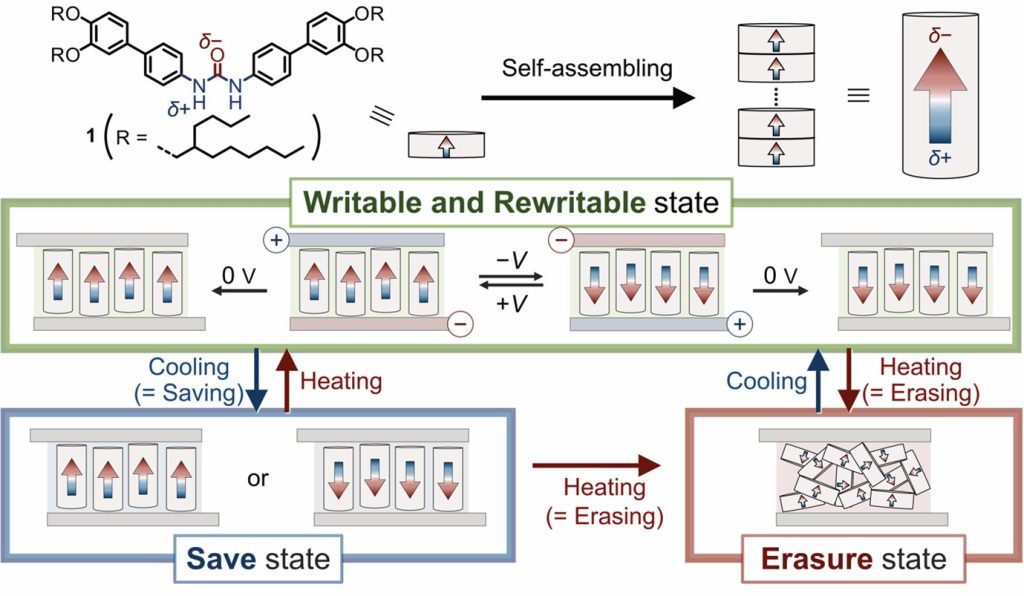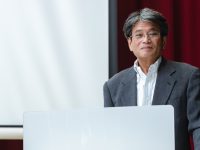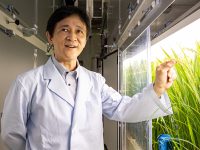Scientists have developed a new urea-based metal-free system that can improve data storage in devices
Current memory storage materials contain toxic and rare metals, which cause significant environmental impact. Metal-free systems for data-storage using liquid crystals—an advantageous alternative for environmental preservation—struggle with susceptibility to external stimuli. Now, researchers from Chiba University have developed a novel urea-based system with long-term information storage ability and high tolerance towards external thermal and electric fields, paving the way for ultra-high-density memory devices.

Image Title: A urea-based axially polar-ferroelectric columnar liquid crystal (AP-FCLC) system
Image Caption: Molecular structure of 1,3-bis(3’,4’-di(2-butyloctyloxy)[1,1’-biphenyl]-4-yl)urea; schematic illustration of columnar molecular aggregates; and concept illustration of writing, rewriting, saving, and erasing in the AP-FCLC system.
Image Credit: Keiki Kishikawa from Chiba University
License Type: Original Content
In today’s world of digital information, an enormous amount of data is exchanged and stored on a daily basis. In the 1980s, IBM unveiled the first hard drive—which was the size of a refrigerator—that could store 1 GB of data, but now we have memory devices that have a thousand-fold greater data-storage capacity and can easily fit in the palm of our hand. If the current pace of increase in digital information is any indication, we require yet newer data recording systems that are lighter, have low environmental impact, and, most importantly, have higher data storage density.
Recently, a new class of materials called axially polar-ferroelectric columnar liquid crystals (AP-FCLCs) has emerged as a candidate for future high-density memory storage materials. An AP-FCLC is a liquid crystal with a structure of parallel columns generated by molecular self-assembly, which have polarization along the column axis. The columns switch their polar directions upon the application of an external electric field. If AP-FCLCs can maintain their polarization even after the electric field is removed, this property, along with their flexibility, metal-free composition, power-saving ability, and low environmental impact, makes AP-FCLCs ideal for ultra-high-density memory devices. Unfortunately, due to the fluid nature of liquid crystals, the polarity induced by an external electric field can get easily undone by external stimuli.
A solution to this problem has now been proposed by a team of researchers from Chiba University, led by Professor Keiki Kishikawa of the Graduate School of Engineering and including Doctoral Course student Hikaru Takahashi of the Graduate School of Science and Engineering and Associate Professor Michinari Kohri of the Graduate School of Engineering. In their recent breakthrough study, made available online on June 12, 2023, and published in Volume 6, Issue 12 of ACS Applied Nano Materials on June 23, 2023, the team presented a polarization fixation mechanism for a urea-based AP-FCLC system, where the materials can undergo a smooth transition from AP-FCLC phase to a crystal (Cr) phase without affecting the induced polar structure.
“The goal was to realize a compound with three states: a writable and rewritable state, an erasure state, and a save state. Emphasis was placed on minimizing the change in molecular packing structures during the FCLC−Cr phase transition process,” explains Prof. Kishikawa.
To create a polarization-fixable AP-FCLC system, the team synthesized 1,3-bis(3’,4’-di(2-butyloctyloxy)[1,1’-biphenyl]-4-yl)urea—an organic molecule consisting of urea at its molecular center for generating a hydrogen bonding network that can facilitate the formation of columnar aggregate in a liquid crystal (LC) state, two biphenyl groups as substituents for generating strong intermolecular interactions in the column structure, and four bulky alkyl groups as terminal chains to prevent tight molecular packing and enable lower-temperature FCLC−Cr phase transition.
The prepared FCLC system exhibited preservation of polarization in the Cr phase, with thermally stable polarization information storage and resistance to the external electrical field at room temperature. Furthermore, we found that the molecules self-sorted into nanosized helical columns, which then formed small domains and became ferroelectric in nature.
This study provides a new strategy for the development of AP-FCLC systems that can maintain their polarization information for a long time. The proposed framework can be used to develop stable memory materials with high tolerance towards external stimuli and low environmental impact. “AP-FCLCs have the potential to achieve more than 10,000 times larger recording density than Blu-ray Discs, but they have not been put into practical use due to the instability issue. This work will help improve their reliability, paving the way for light-weight flexible electronic devices and incinerable confidential information-recording devices,” concludes Prof. Kishikawa.
With these new liquid crystals, the future of memory storage looks secure!
About Professor Keiki Kishikawa from Chiba University
Dr. Keiki Kishikawa is a Professor at the Graduate School of Engineering at Chiba University, Japan. He received his bachelor’s and master’s degrees in Industrial Chemistry from Chiba University, followed by a doctoral degree in Mathematics and Materials Sciences. His current areas of research interest include nanostructures, ferroelectrics, materials chemistry, and liquid crystals. He has published over 200 research articles, which have been cited more than 4,500 times. He was awarded the JLCS Award for Outstanding Achievement from The Japanese Liquid Crystal Society in 2021.
Reference:
Title of original paper: Axially Polar-Ferroelectric Columnar Liquid Crystalline System That Maintains Polarization upon Switching to the Crystalline Phase: Implications for Maintaining Long-Term Polarization Information
Authors: Hikaru Takahashi1, Michinari Kohri2, and Keiki Kishikawa2
Affiliations:
- Department of Applied Chemistry and Biotechnology, Faculty of Engineering, Chiba University
- Department of Applied Chemistry and Biotechnology, Faculty of Engineering and Molecular Chirality Research Center, Chiba University
Journal: ACS Applied Nano Materials
DOI: 10.1021/acsanm.3c01508
Contact: Prof. Keiki Kishikawa
Graduate School of Engineering, Chiba University
Email: kishikawa@faculty.chiba-u.jp
Public Relations Office, Chiba University
Address: 1-33 Yayoi, Inage, Chiba 263-8522 JAPAN
Email: koho-press@chiba-u.jp
Tel: +81-43-290-2018
Recommend
-

Understanding the Relationship between Diseases and Membrane Protein Structure
2022.07.26
-

Live on the Moon, Settle on Mars: Research Center for Space Agriculture and Horticulture for Space Food Production and Supply
2023.10.20
-

Plant factory: sustainable plant production on Earth and in outer space
2022.10.06



